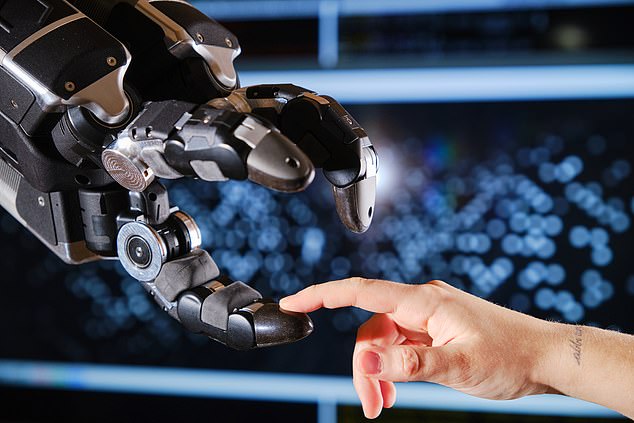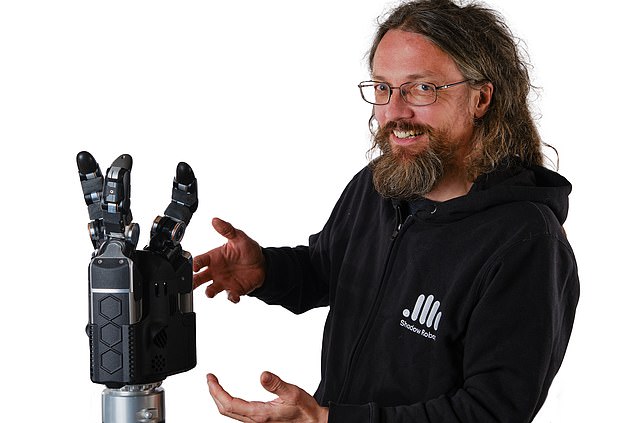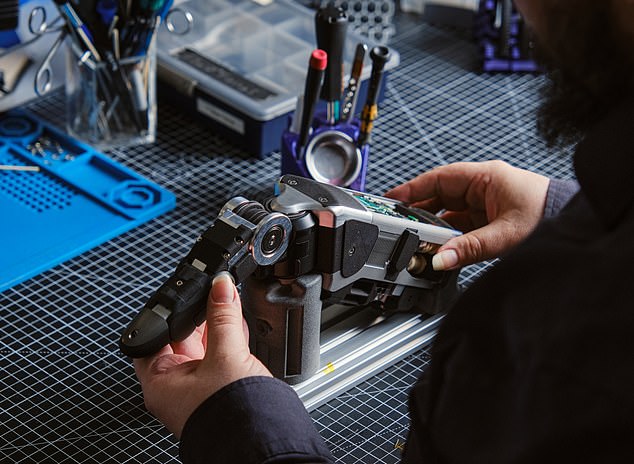A huge, super-fast, indestructible robotic hand might seem like a scary prop from a sci-fi movie.
But this 9.9-pound (4.1 kg) heavy hand is very real and is already being used to develop the next generation of artificially intelligent robots.
Designed by UK-based Shadow Robot Company, this three-fingered claw can go from fully open to closed in just 500 milliseconds.
However, the robot’s hand is still sturdy enough to withstand being hit with hammers or pistons.
That toughness is designed to help the hand survive the rigorous and often destructive process of teaching the AI how to interact with the world.
Indestructible machines may seem like a terrifying idea straight out of Terminator (pictured), but this beefy robotic fist could be key to helping train the AI of the future.
About 50 percent larger than a human hand and with only three fingers, this robot is not as human-like as many others out there.
However, according to Rich Walker, director of Shadow Robot Company, that chunky design is a necessary trade-off.
Designed over four years with artificial intelligence company Google Deepmind, the main goal of the hand is to help teach artificial intelligence.
While robots in factories can follow simple routines such as moving sheets of metal from one place to another, the real world requires more complex movements.
For robots to perform more complex tasks or act autonomously, they will need AI to drive their motor controls.
But the process of teaching AI to control a robot can be particularly costly and destructive for the robots involved.

The latest robotic hand from UK-based Shadow Robot Company has been designed to withstand the rigorous and often destructive AI training process.
Walker told MailOnline: “If you’ve ever seen a baby learning, at the beginning of the process they move randomly before they start to connect those movements to what they can see in front of them.”
When you put AI in control of a robot, the process is very similar, the only difference is that robots are not as resilient as humans.
To learn a simple task like picking up objects, AIs need to perform thousands of repeated trial and error attempts.
Last year, researchers at UC Berkeley used this technique to teach an AI how to pick up clothes through repetition.
However, those early stages of the learning process are often so erratic that it is not uncommon for robots to fall apart.

Shadow Robot Company director Rich Waker (pictured) says training AI leads to rapid, random movements that can often tear robots to pieces. This meant they had to design a much larger and stronger option.
Walker explained: ‘What you and I call touching something, people in the robotics community call collision.
“Robots typically avoid collisions because collisions are bad and cause damage.”
To prevent robots from simply breaking into pieces while learning, Shadow Robot Company has had to really toughen its hand.
Shadow Robot Company uses a combination of larger, stronger parts and motor controls that allow fingers to move with impacts and prevent damage.
Each finger is also a modular component, so it can be quickly changed if there is any damage.
However, to be useful in developing machine learning, the hand must also be sensitive.
Each fingertip has hundreds of tiny cameras beneath the surface that focus inside your skin.

This hand weighs 4.5 kg (9.9 lb) and each finger weighs 1.2 kg (2.6 lb), allowing it to withstand hits from hammers or pistons.
When the hand grasps an object, these cameras detect how the skin deforms and can determine how hard or soft the object may be.
Walker says the hand is currently in manufacturing, so there is no confirmed price currently.
However, he told MailOnline: “This will not be a cheap robot, but it will certainly be cheaper than other robots we have made in the past.”
He explains that the robotic hand is actually cheaper to make than others because it is designed with spare parts and easy repair in mind.
Although the hand was developed for and with DeepMind, Walker says it will also be sold to other companies and research institutions.
He adds that robotics researchers he’s spoken to are excited to have “robots we can attack now.”

